
 |
| |
The Corrsin Wind Tunnel Laboratory:
|
||
|
|
The
Corrsin Wind Tunnel is named after the late Hopkins professor Stanley
Corrsin (left), who designed and built this facility to study fundamentals
of turbulent flow. Many landmark papers in the field of turbulence
(e.g. Comte-Bellot & Corrsin, J. Fluid Mech. 48 (1971),
p. 273) are based on measurements in this wind tunnel. It is a closed
loop, two-storey facility, with a primary contraction-ratio of 25:1,
a secondary contraction of 1.27:1 (to enhance isotropy of turbulence
generated downstream of a grid) and an approximately 10 meter long,
1m by 1.3m wide, test-section. Speeds of up to 32 m/s can be achieved.
The laboratory is equipped with several multiprobe hot-wire and cold-wire
anemometry and high-speed multi-channel data acquisition systems.
Also a stereo-PIV system with a large data storage system is available
for planar velocity measurements. The wind-tunnel laboratory is housed
in the basement of Maryland Hall of the Johns Hopkins University (shown
at left). |
||
|
|
|||
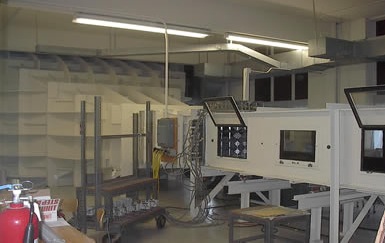 |
|||
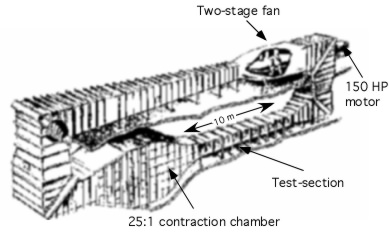 |
|||
Hot-Wire Calibration unit
|
Active Grid
|
||
| The JHU Rapid straining facility:
|
|||
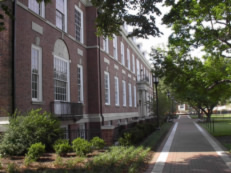 |
The
facility consists of a 3.3 x 0.2 x1.27 m^3 water tank in which turbulence
is generated by four high-speed rotating grids. It was constructed by
graduate student Jun Chen in a collaboration
with Prof. J.
Katz. The facility is housed in the basement of Latrobe Hall (see
photo at left), in the Laboratory
for Experimental Fluid Dynamics. The figure below shows a functional
sketch, and is followed by a rendering image of the facility. |
||
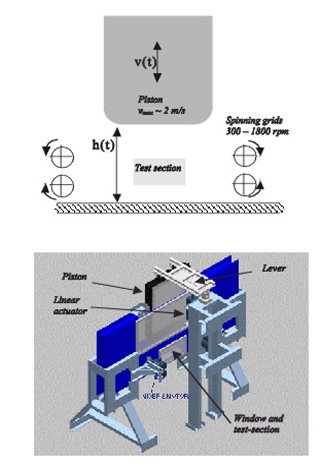 |
|||
| Turbulence with no mean velocity is generated by four symmetrically placed spinning grids. In the present facility the grids can be rotated up 1800 rpm, so we may possibly exceed u'~0.5 m/s and Rl ~ 600. The distance between the grids and the test-section is 63 cm. Turbulence diffuses towards the central test-section, setting up nearly isotropic homogeneous turbulence there. During the experiments, a piston with rectangular cross-section of 100 x 20 cm^2 is pushed from the top downwards towards the bottom of the tank, setting up a planar straining field there. The piston is driven by an Exlar linear actuator (GS-6010), which is controlled by an Emerson motion control system (MX-1600 power amplifier + AXIMA 2000 motion control unit), through magnification of a lever. Former graduate student Jun Chen is shown next to the facility at right. |
|
||
|
|
Computational facilities:
|
|
Computational studies
and large-scale simulations are performed on various platforms. In collaboration
with Profs. S.
Chen and J.
Katz, a Beowulf cluster computer has been constructed in the fluid
mechanics group of the Department of Mechanical Engineering at the Johns
Hopkins University with an NSF grant
for major research instrumentation. This cluster computer consists of
65 nodes of commodity personal computers. Each node contains 1GHz AMD
processor, 512Mbytes memory and 20Gbytes hard-disk space. The Wulfkit
based on Dolphin's high-speed low latency SCI interconnect technology
is used to connect all processors which allows approximately 1Gbits/per
second communication speed among processors. A 1Tbytes SAN is also included
to provide large data storage. |
||
|
Each of the members of the Turbulence Research Group has at his/her disposal a PC running LINUX for smaller preliminary simulations and code development. Some calculations are also performed on the Departmental Silicon Graphics Power Challenge L (with six R8000 processors, 512 Megabytes of RAM and over 40 Gigabytes of disk space) and Origin workstations, and on National Supercomputing Centers such as NCAR's Supercomputing Center. |
| The JHU axial turbomachine facility:
|
|||
In order
to provide full optical access to measure complex flow phenomena in axial
turbomachines, a refractive index matched facility has been constructed
in the Laboratory for Experimental
Fluid Dynamics in a collaboration with Prof.
J. Katz. The facility has been constructed with funds from12/13/2013 and ONR. |
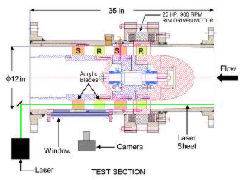 |
||
| The test section contains a two-stage axial turbo pump with rotor and stator blades that are made of transparent acrylic. Their refractive index is matched with a 62 % by weight solution of Sodium Iodide in water. The liquid has a specific gravity of 1.8 and a kinematic viscosity of about 1.08 x 10^-6 m^2/s (depending on temperature) which is almost the same as water. This kind of setup allows full optical access to the entire rotor and stator passages without the laser sheet being reflected, blocked or scattered. More details are given in the ~lefd web-site on turbomachine research. The drawing below shows a plan view of the facility, and the photograph that follows shows postdoctoral fellow Dr. Oguz Uzol (right) and LEFD graduate student Yi-Chih Chow (left) examining the optical setup. |
|||
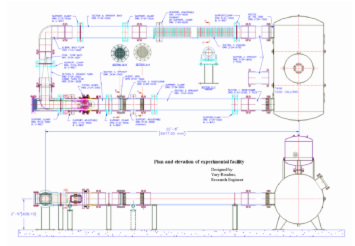 |
|||
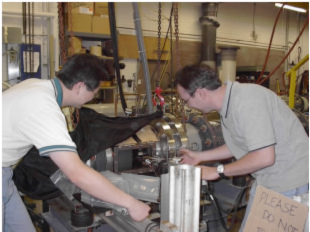 |
|||
|
Charles
Meneveau | Department of Mechanical Engineering | Johns Hopkins
University 3400 N. Charles Street | Baltimore, MD 21218 | USA Phone: 1 (410) 516-7802 | Fax: 1 (410) 516-7254 | Email: meneveau@jhu.edu |
||
|
Last
update:
December 13, 2013
|
||